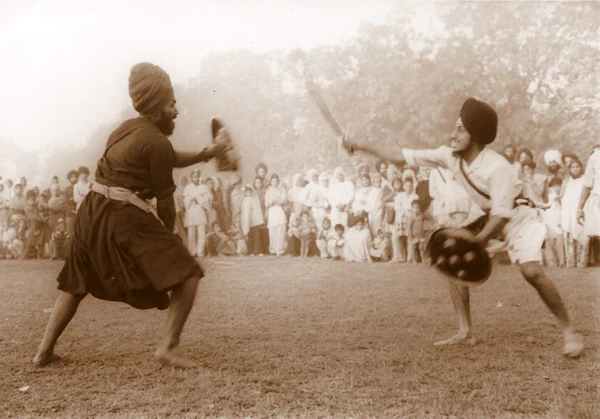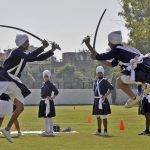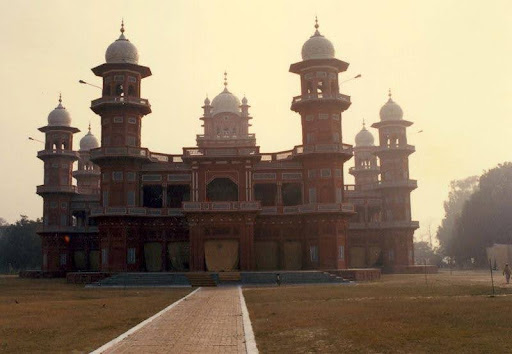It’s fun to see Gatka’s performances! To witness Gatka in all its splendor, go to the Hola Mohalla celebrations in Anandpur in March. Alternatively, you might visit some of the best Gatka akharas to observe this Sikh warrior fighting style in action. Nothing less than a dramatic performance that captivates you with its magnetism can compare to watching these athletes train because of their dexterous motions while holding a shield and a sword in tandem. Everyone is fascinated by the Gatka display’s rhythmic movements. Fast dhol or drum beats reverberate, swords and shields smash, and jack (war cries) are eagerly greeted by the crowd as the blade glides swiftly in simple circles to the rhythm of the drum.
Gatka finds its roots in the time of Guru Hargobind Sahib, the sixth Sikh Guru, who emphasized the importance of self-defense and physical fitness among his followers. Recognizing the need to protect themselves and others from oppression, the Sikh Gurus encouraged the practice of martial arts as a means of defense and maintaining peace. The principles of Gatka are deeply intertwined with the core values of Sikhism, such as bravery, equality, and justice.
At its core, Gatka is a weapon-based martial art form that primarily involves the use of swords, spears, and shields. The techniques and movements are meticulously designed to train individuals in both offensive and defensive strategies, promoting agility, precision, and discipline. The training not only enhances physical strength and coordination but also cultivates mental focus and resilience.
Gatka is not limited to the mere display of combat skills; it encompasses a holistic approach to martial arts. The practitioners, known as Gatka performers or Akalis, engage in various forms of physical exercises, meditation, and spiritual practices, aiming to develop a well-rounded individual who is not only skilled in combat but also spiritually grounded. The practice of Gatka is considered a form of seva (selfless service) and a means of connecting with the divine.
Throughout history, Gatka has played a vital role in safeguarding Sikh communities from external threats and preserving their unique identity. During times of persecution and oppression, Sikh warriors trained in Gatka defended their faith and protected the innocent. Their valor and unwavering commitment to justice became legendary, inspiring future generations of Sikhs to uphold their heritage and stand against injustice.
Despite the challenges faced by the Sikh community over the years, Gatka has endured as a symbol of resilience and cultural pride. In the face of adversity, Gatka has served as a unifying force, bringing Sikhs together and reminding them of their shared history and values. Gatka performances are commonly witnessed during religious and cultural festivals, where performers showcase their skills and celebrate the legacy of Sikh warriors.
In recent years, efforts have been made to promote Gatka on a global scale, ensuring that its rich heritage is not confined to Sikh-majority regions alone. Gatka academies and training centers have been established in various countries, providing individuals from diverse backgrounds an opportunity to learn and appreciate this unique martial art form. Sikh youth, in particular, are encouraged to embrace Gatka as a means of preserving their cultural roots and connecting with their Sikh identity.
Moreover, Gatka has transcended the boundaries of a mere martial art and has become a medium for fostering interfaith dialogue and promoting peace. Sikh organizations and institutions often organize demonstrations and workshops to educate others about Gatka’s values and principles. By sharing the art form’s philosophies of respect, discipline, and harmony, Sikhs aim to foster understanding and build bridges of tolerance and acceptance.
In conclusion, the rich heritage of Sikh Gatka serves as a testament to the resilience and martial prowess of the Sikh community. Rooted in the teachings of the Sikh Gurus, Gatka embodies the core values of Sikhism, emphasizing the importance of self-defense, bravery, and justice. As a symbol of Sikh identity and cultural pride, Gatka continues to be practiced and celebrated, ensuring that the traditions of the faith are preserved for future generations. Gatka was presented to the Sikhs by Guru Hargobind, the sixth Sikh Guru. The Guru is supposed to salute the weapons before starting the practice. Why not, then? When fighting injustice, helping the needy, and defending morality require the use of firearms. He spread the idea of Miri-Piri (temporal power-spiritual power) and stressed the need to uphold dharma (righteousness). It is hence frequently seen as both a spiritual and physical practice.
Through an uninterrupted history of ustads (masters), the styles and methods of Gatka are taught in numerous akharas (arenas) all over the world. Gatka has undergone rigorous combat testing and was utilized in the Sikh Wars.
Through its holistic approach to martial arts, Gatka not only cultivates physical strength and discipline but also fosters spiritual growth and a deep connection with the divine. By sharing Gatka’s principles of respect and harmony, Sikhs strive to promote interfaith dialogue and contribute to a more peaceful and inclusive world.








